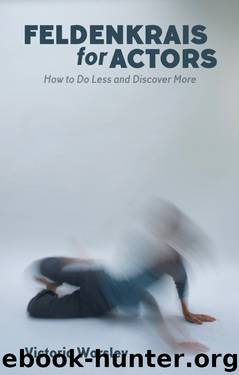Feldenkrais for Actors: How to Do Less and Discover More by Victoria Worsley

Author:Victoria Worsley [Worsley, Victoria]
Language: eng
Format: epub
Tags: Arts & Photography, Performing Arts, Theater, Acting & Auditioning
Amazon: B01MQDTPM6
Publisher: Nick Hern Books
Published: 2016-11-09T22:00:00+00:00
The literature around perception and how our brain orders the world and makes meaning is vast, ranging from Merleau Ponty to John Berger and beyond, and I am not going to even dip my toe in it. It is enough to observe that we are adept at making meaning – and will do so out of whatever clues we have. Take a photo of a reasonably expressionless face and see how you read it differently depending on what pictures you put before it and after it. If you use images of sun-dappled woodland glades and flowers and a group of people having a picnic, the face will seem to be expressing a different emotion than if you use images of violence or death around it. You can get the same effect putting different music behind an image on a screen or a scene in a play. It’s one of the fundamental ideas behind any montage or editing technique, from Battleship Potemkin through Hitchcock and onwards. In the examples I gave, the picture of the face itself does not need to show anything as the watcher will always do the work to create meaning from the context.
I remember doing an exercise with director Neil Bartlett where, one by one, we just sat in a chair, looked at the door for several minutes, then stood up slowly and went to open it. We did nothing else: thought as little as possible, acted as little as possible, kept it as simple as we could manage. Everyone watching had a story for what was going on, for, as John Wright says, meaning rushes into a vacuum. The audience does the work. The power in the actor doing less is that the audience, busy finding meaning, often sees and experiences more.
Neutral Mask
This exercise also sounds like something you might do if you work with neutral mask. Neutral mask is an excellent tool in exploring how you can let go of unnecessary effort and do less. It is a great partner to Feldenkrais work. The neutral mask was developed by Jacques Lecoq from Copeau’s ‘Noble Mask’,64 and is a full, plain white or leather mask with a very simple, well-defined, symmetrical face. This invites utter simplicity of movement in the wearer and is wonderful for revealing the gaps in the person’s ability to answer that invitation (unlike the character masks that are sometimes very expressive and seem to demand a pronounced style of movement and behaviour).
Jacques Lecoq developed a very specific ‘elemental journey’ for teaching with neutral masks, which is excellent and the best known way of working with them, but they are also very useful in a number of other ways. Think of Copeau’s game in which an actor stands in front of the audience with the idea of being simple and at ease, and the audience’s job is to register how much difficulty the actor has just being there. In a workshop John Wright and I were teaching together, we were playing that game.
Download
This site does not store any files on its server. We only index and link to content provided by other sites. Please contact the content providers to delete copyright contents if any and email us, we'll remove relevant links or contents immediately.
| Acting & Auditioning | Broadway & Musicals |
| Circus | Direction & Production |
| History & Criticism | Miming |
| Playwriting | Puppets & Puppetry |
| Stage Lighting | Stagecraft |
Call Me by Your Name by André Aciman(20380)
Ready Player One by Cline Ernest(14534)
How to Be a Bawse: A Guide to Conquering Life by Lilly Singh(7397)
Wiseguy by Nicholas Pileggi(5675)
The Kite Runner by Khaled Hosseini(5088)
On Writing A Memoir of the Craft by Stephen King(4866)
Audition by Ryu Murakami(4855)
The Crown by Robert Lacey(4732)
Call me by your name by Andre Aciman(4624)
Gerald's Game by Stephen King(4584)
Harry Potter and the Cursed Child: The Journey by Harry Potter Theatrical Productions(4446)
Dialogue by Robert McKee(4328)
The Perils of Being Moderately Famous by Soha Ali Khan(4171)
Dynamic Alignment Through Imagery by Eric Franklin(4126)
Apollo 8 by Jeffrey Kluger(3640)
Seriously... I'm Kidding by Ellen DeGeneres(3578)
The Inner Game of Tennis by W. Timothy Gallwey(3576)
How to be Champion: My Autobiography by Sarah Millican(3558)
Darker by E L James(3481)
